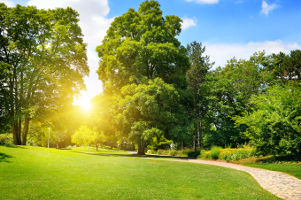When you think of nature, your mental image may include deer calmly eating grass, or a flowing stream, or some blooming flowers and chirping birds, but amid all of this you almost certainly have included a backdrop of trees. These great wooden beings are a model of natural resilience and fortitude—with a solid, sturdy, immovable body and a lifespan that far exceeds ours, trees seem to embody the sort of health we humans can only dream of. But did you know that trees, by their mere presence, exert a profound positive influence on our own health?
Trees not only improve our psychological health when we are near them, but they also serve an important purpose in preserving our health by combating air pollution, especially in dense urban areas. Learning about how they provide these benefits and how to increase their presence and protect them from both natural and man-made threats is a key to safeguarding not only the environment but also public health.
How Trees Improve Mental Health
Even before scientists understood the extent of the impact that trees’ air filtration processes have on pollution and public health, there was extensive research into the various ways that trees benefit human health via their effect on our psychological states.
Studies conducted at the University of Rochester and published in the Journal of Environmental Psychology found that nature has an invigorating effect on people, making them prone to describing themselves as feeling “more alive” than when not in nature.
Of course, you may be thinking that something else must be responsible—that people exercise more outdoors, or get more human interaction, or something along those lines. But these experiments were meticulously crafted to isolate nature as the true variable responsible for this feeling of invigoration.
The researchers compared subjects asked to walk through indoor hallways to those asked to walk through a forest path of similar length. They also asked subjects to look at photographs of either buildings or landscapes. Other subjects were asked to imagine themselves in various situations both active and inactive, outdoor and indoor, with or without others. Across all of these experiments, the experience of nature always provided the feeling of vitality. Even experiencing nature via indoor plants or looking out a window, or simply imagining oneself in nature or recalling an outdoor memory had an effect, demonstrating the power that nature has in positively influencing our mental state.
These findings are supported by a later study that showed that living in an area with more green space correlates with lower cortisol levels. Cortisol is the stress hormone, and these results built on previous research that had suggested that “contact with natural environments promotes psychological restoration, improved mood, improved attention and reduced stress and anxiety.”
This is important because those who feel healthier also actually are more resistant to disease—a sort of placebo effect, if you will.
Not only that, but spending time in nature has been shown to improve creativity, so much so that even merely looking at the color green is enough to give your creativity a boost.
With all these benefits and more sure to be found with further research, it’s clear that increasing the presence of trees in our lives is an important step in facilitating better mental health in our populace.
How Trees Improve Physical Health
But trees do so much more than simply improve our moods. They serve as an indispensable tool for improving and maintaining the public’s physical health as well.
You may remember learning in grade school about how trees produce oxygen by absorbing carbon dioxide, but that’s not the only thing that trees absorb. Trees filter the air around them by pulling particulates, ozone, and other pollutants into their stomata, the pores on their leaves.
Maybe this doesn’t seem like much—the air is a bit cleaner, so what? How significant of an effect could the trees really have when set against the massive amounts of cities our cities produce? But the statistics that research has produced are worth taking a look at.
In one year alone, trees in the U.S. prevent 850 deaths and 670,000 cases of acute respiratory symptoms. Of course, a tree has a much bigger impact in areas where they are more seldom found and there is more pollution and population density, i.e. urban centers. But even still, regardless of age, race, income, or any other demographic factor, everyone experiences health benefits from being near more trees. When surveying the populace of Toronto and controlling for other variables, researchers from the University of Chicago found that, controlling for other factors, adding ten trees to the block you live on has an equivalent effect on your risk of cardio-metabolic conditions like heart disease, diabetes, and strokes as a pay increase of $20,000 per year or an age reversal of 1.4 years younger.
All of these health benefits translate to an estimated $6.8 billion in prevented healthcare spending.
Unfortunately, the effects trees have are also seen in what happens when they disappear. A study published in the American Journal of Preventative Medicine surveyed 1,296 counties in fifteen states over the course of eighteen years. It found that areas ravaged by the emerald ash borer beetle, which destroys trees so rapidly that it can leave places treeless, had over 15,000 more deaths from heart disease and over 6,000 more deaths from respiratory disease because of the tree-killing pest.
Statistics like these make it abundantly clear just how necessary it is to encourage the planting of more trees as a measure not just for beautification, but for the betterment of public health. Trees, due to both the invaluable service they provide by filtering our air and the psychological good they do all those who spend time around them, are in indispensable public resource to be treasured.
If you want to learn how you can help bring more trees into our neighborhoods, as well as protect the ones already there, you might consider getting involved with greening efforts like those led by Gateway Green. If you’d like to contact Chicago Gateway Green to ask questions or volunteer, simply fill out a contact form or give us a call at 312-527-9621.
Help us fill the world with trees—who knows, someday they might save your life.
Chicago Gateway Green
1000 N Milwaukee Ave Suite 302
Chicago IL 60642
(312) 527-9621

